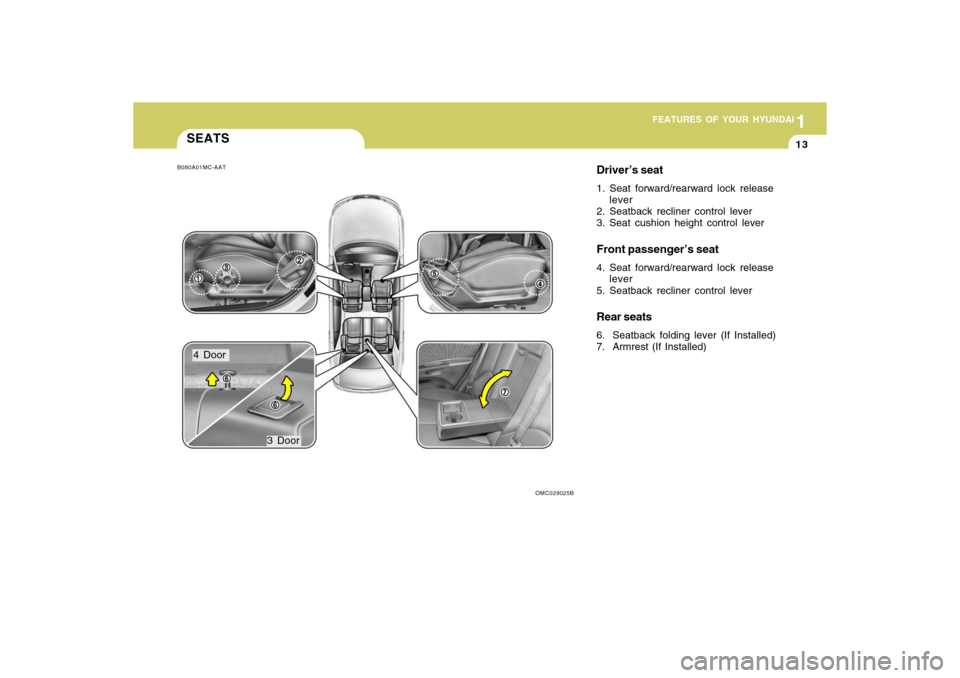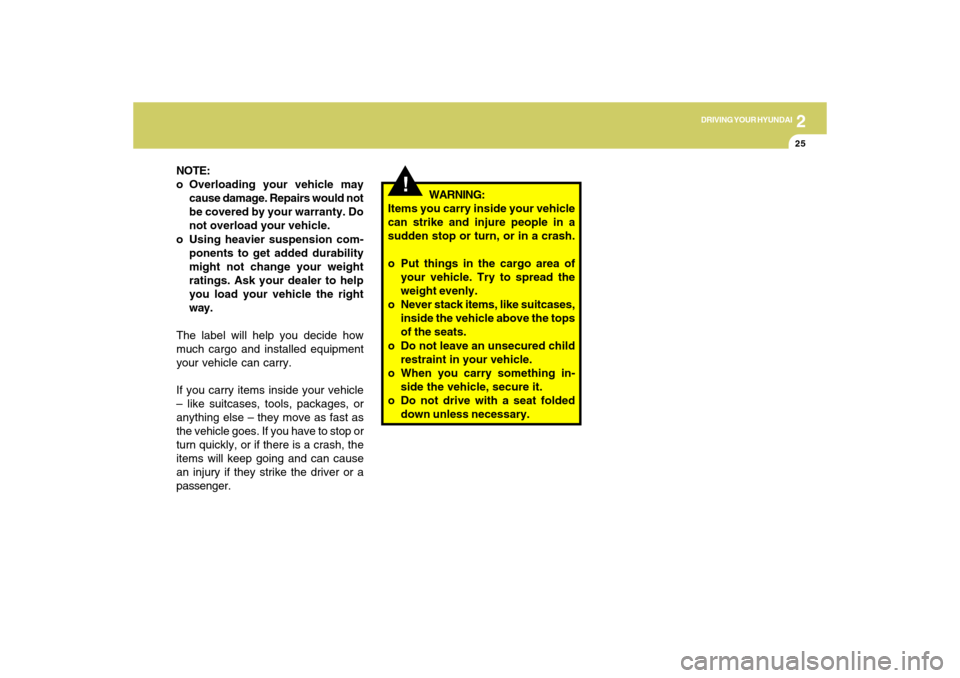2009 Hyundai Accent fold seats
[x] Cancel search: fold seatsPage 23 of 266

1
FEATURES OF YOUR HYUNDAI
131
FEATURES OF YOUR HYUNDAI
13
SEATS
Driver’s seat1. Seat forward/rearward lock release
lever
2. Seatback recliner control lever
3. Seat cushion height control leverFront passenger’s seat4. Seat forward/rearward lock release
lever
5. Seatback recliner control leverRear seats6. Seatback folding lever (If Installed)
7. Armrest (If Installed)
B080A01MC-AAT
OMC029025B
4 Door
3 Door
Page 29 of 266

1
FEATURES OF YOUR HYUNDAI
191
FEATURES OF YOUR HYUNDAI
19
Adjusting the height up and down
(If Installed)To raise the headrest, pull it up to the
desired position (1). To lower the head-
rest, push and hold the release button (2)
on the headrest support and lower the
headrest to the desired position (3).
Removal (If Installed)To remove the headrest, raise it as far as
it can go then press the release button (1)
while pulling upward (2).
To reinstall the headrest, put the headrest
poles (3) into the holes while pressing the
release button (1). Then adjust it to the
appropriate height.
OMC029045
OMC029046
!
WARNING:
Make sure the headrest locks in position
after adjusting it to properly protect the
occupants.
!
B110A02MC-AATFolding Rear SeatbacksThe rear seatbacks may be folded to
facilitate carrying long items or to increase
the luggage capacity of the vehicle.
WARNING:
The purpose of the fold-down rear
seatbacks is to allow you to carry longer
objects than could otherwise be accom-
modated.
Never allow passengers to sit on top of
the folded down seatback or cargo area
while the car is moving as this is not a
proper seating position and no seat belts
are available for use. This could result in
serious injury or death in case of an
accident or sudden stop. Objects car-
ried on the folded down seatback should
not extend higher than the top of the front
seats. This could allow cargo to slide
forward and cause injury or damage
during sudden stops.
Page 30 of 266

1FEATURES OF YOUR HYUNDAI20
3. Pull up the seatback folding lever to
release the seatback. o Before folding the seatback, insert
the buckle in the pocket. This can
prevent the buckle from being dam-
aged by the seatback.
B110A01MC
To fold down the seatback :1. Slide the front seats forward and ad-
just the front seatbacks to be upright
before folding the rear seatbacks down.
2. Lower the rear seat headrests to the
lowest position.
B220D05MC
o In order to prevent the center shoul-
der belt from being damaged while
folding the rear seat, disconnect the
metal tab (A) from the buckle (B). To
disconnect the metal tab (A) from
the buckle (B) , insert a narrow-ended
tool into the groove located on the
buckle (B).
!
CAUTION:
B090A02MCOMC029041
4 Door3 Door
Page 41 of 266

1
FEATURES OF YOUR HYUNDAI
311
FEATURES OF YOUR HYUNDAI
31
!
B220D05MC
To disconnect the metal tab (A) from the
buckle (B), insert a narrow-ended tool
into the groove located on the buckle (B).
WARNING:
Always lock metal tab (A) into buckle (B)
immediately after returning the rear
seatbacks to an upright position. This
portion of the rear center seat belt should
only be unbuckled when the rear
seatback is folded down.
!
B220C02A-GATTo Release the Seat BeltWhen you want to release the seat belt,
press the button in the locking buckle.
WARNING:
When fastening the outboard seat belts
or the center seat belt, make sure they
are inserted into the correct buckles to
obtain maximum protection from the seat
belt system and assure proper opera-
tion.
B210A01NF
CHILD RESTRAINT SYSTEMB230A05A-AATChildren riding in the car should sit in the
rear seat and must always be properly
restrained to minimize the risk of injury in
an accident, sudden stop or sudden
maneuver. According to accident statis-
tics provided by the National Highway
Traffic Safety Administration (NHTSA),
children are safer when properly re-
strained in the rear seats than in the front
seat. Larger children not in a child re-
straint should use one of the seat belts
provided.
All 50 states have child restraint laws.
You should be aware of the specific re-
quirements in your state. Child and/or
infant safety seats must be properly placed
and installed in the rear seat. You must
use a commercially available child re-
straint system that meets the requirements
of the Federal Motor Vehicle Safety Stan-
dards (FMVSS).
Child restraint systems are designed to
be secured in vehicle seats by lap belts
or the lap belt portion of a lap/shoulder
belt, or by a LATCH system (If Installed).
Children could be injured or killed in a
crash if their restraints are not properly
secured.
Page 68 of 266

1FEATURES OF YOUR HYUNDAI58
B240D02NF-AATAdditional Safety PrecautionsoNever let passengers ride in the
cargo area (trunk) or on top of a
folded-down back seat. All occupants
should sit upright, fully back in their
seats with their seat belts on and their
feet on the floor.
oPassengers should not move out of
or change seats while the vehicle is
moving. A passenger who is not wear-
ing a seat belt during a crash or emer-
gency stop can be thrown against the
inside of the vehicle, against other
occupants, or out of the vehicle.
oEach seat belt is designed to re-
strain one occupant. If more than one
person uses the same seat belt, they
could be seriously injured or killed in
a collision.
oDo not use any accessories on seat
belts. Devices claiming to improve oc-
cupant comfort or reposition the seat
belt can reduce the protection pro-
vided by the seat belt and increase the
chance of serious injury in a crash.
oPassengers should not place hard or
sharp objects between themselves
and the airbags. Carrying hard or
sharp objects on your lap or in your
mouth can result in injuries if an airbag
inflates.
!
WARNING:
o No objects should be placed over or
near the airbag modules on the steer-
ing wheel, instrument panel, and the
front passenger's panel above the
glove box, because any such object
could cause harm if the vehicle is in
a crash severe enough to cause the
airbags to inflate.
o If the airbags inflate, they must be
replaced by an authorized Hyundai
dealer.
o Do not tamper with or disconnect
SRS wiring, or other components of
the SRS system. Doing so could re-
sult in injury, due to accidental infla-
tion of the airbags or by rendering
the SRS inoperative.
o If components of the airbag system
must be discarded, or if the vehicle
must be scrapped, certain safety
precautions must be observed. Your
Hyundai dealer knows these precau-
tions and can give you the neces-
sary information. Failure to follow
these precautions and procedures
could increase the risk of personal
injury.
!
WARNING:
o If your car was flooded and has
soaked carpeting or there is water
on the floor, do not start the engine;
have the car towed to an authorized
Hyundai dealer.
Page 168 of 266

DRIVING YOUR HYUNDAI
252
NOTE:
o Overloading your vehicle may
cause damage. Repairs would not
be covered by your warranty. Do
not overload your vehicle.
o Using heavier suspension com-
ponents to get added durability
might not change your weight
ratings. Ask your dealer to help
you load your vehicle the right
way.
The label will help you decide how
much cargo and installed equipment
your vehicle can carry.
If you carry items inside your vehicle
– like suitcases, tools, packages, or
anything else – they move as fast as
the vehicle goes. If you have to stop or
turn quickly, or if there is a crash, the
items will keep going and can cause
an injury if they strike the driver or a
passenger.
!
WARNING:
Items you carry inside your vehicle
can strike and injure people in a
sudden stop or turn, or in a crash.
o Put things in the cargo area of
your vehicle. Try to spread the
weight evenly.
o Never stack items, like suitcases,
inside the vehicle above the tops
of the seats.
o Do not leave an unsecured child
restraint in your vehicle.
o When you carry something in-
side the vehicle, secure it.
o Do not drive with a seat folded
down unless necessary.
Page 265 of 266

10
INDEX
5
R
Rear Seat
Folding rear seatbacks ...................................................1-19
Warning...........................................................................1-22
Rear Window Defroster Switch .........................................1-81
Reporting Safety Defects ...................................................8-18
S
Seats ...................................................................................1-13
Front ................................................................................1-14
Rear.................................................................................1-18
Seat Belts ...........................................................................1-22
3-Point system ................................................................1-26
Adjusting your seat belt ..................................................1-28
Care of seat belts ...........................................................1-25
Pre-tensioner seat belt ...................................................1-39
Precautions.....................................................................1-22
Speedometer......................................................................1-71
Starting Procedure ............................................................... 2-5
Steering Wheel Tilt Lever ................................................1-101
Stereo Sound System ......................................................1-117
Sun Visor ............................................................................1-99
Sunglass Holder ................................................................1-88
Sunroof...............................................................................1-84T
Tachometer.........................................................................1-70
Theft-Alarm System .............................................................. 1-8
Tire Pressure Monitoring System (TPMS) ........................... 3-5
Tires
All season tires ...............................................................8-10
Balancing........................................................................8-12
Chains.............................................................................8-10
Changing a flat tire .........................................................3-11
Checking the inflation pressure ....................................... 8-5
If you have a flat tire .......................................................3-11
Information........................................................................ 8-3
Maintenance...................................................................8-13
Pressure............................................................................ 8-3
Replacement...................................................................8-12
Rotation...........................................................................8-11
Sidewall labeling.............................................................. 8-6
Snow tires .......................................................................8-10
Spare tire ........................................................................3-10
Terminology and definitions ............................................. 8-8
Traction...........................................................................8-12
Towing
A trailer (or vehicle) ........................................................2-20
Emergency......................................................................3-18
If your vehicle must be towed ........................................3-16